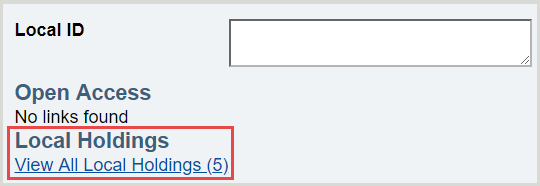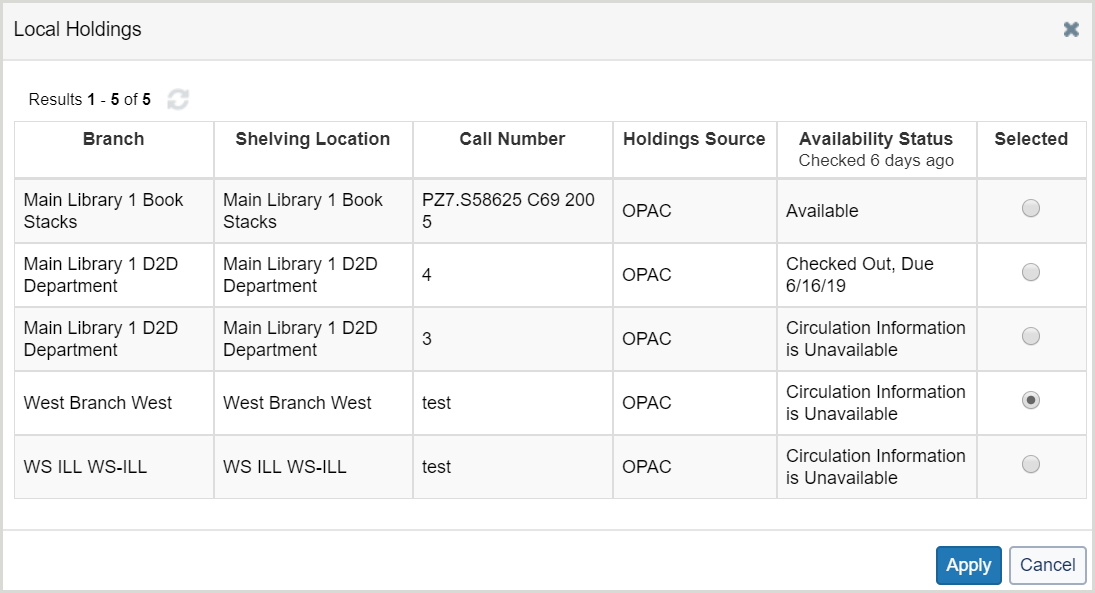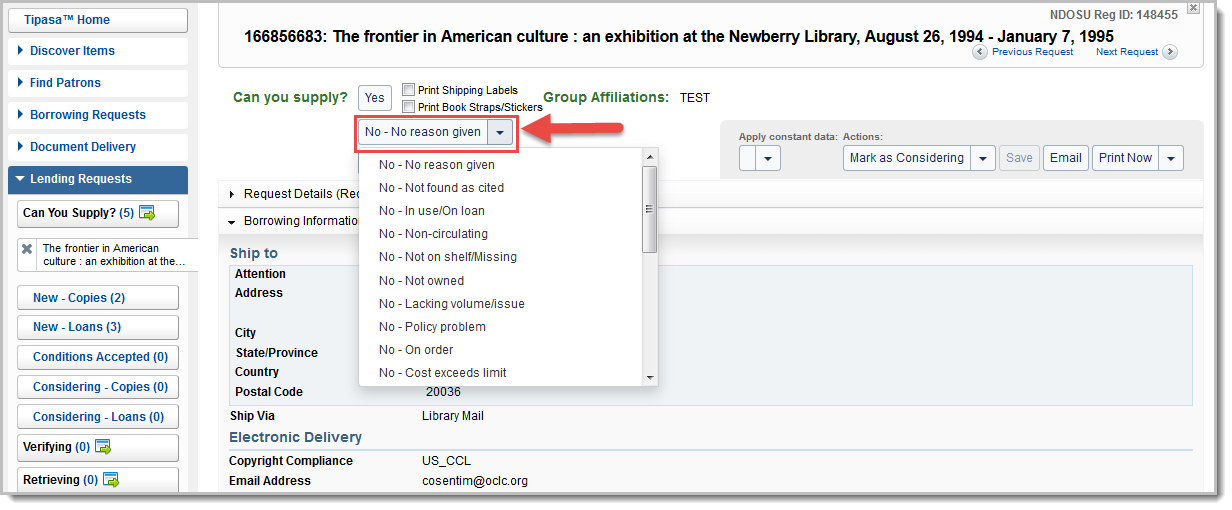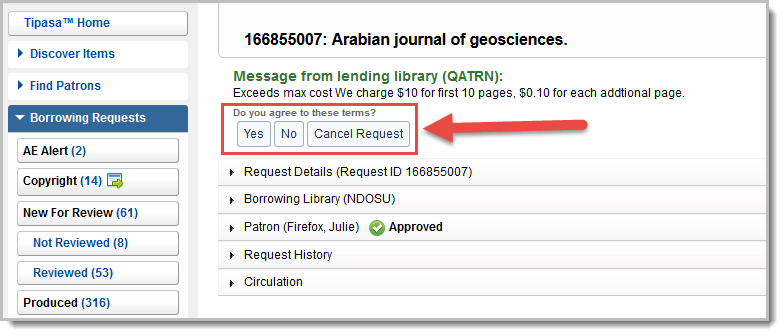Respond to requests
Follow the instructions below to respond to requests.
View local holdings and availability for lending requests
If your library has enabled local holdings and availability, lending requests will display local holdings information for items held by your institution.
- If you are a WMS library, please see OPAC integration for more information about enabling this feature.
- If you are an Alma or Sierra library, please contact OCLC Support to discuss enabling this feature.
Real-time availability
Real-time availability enables the system to automatically respond No to lending requests that have an OPAC status of unavailable. This allows the requests to move through the lender string more quickly.
Lending requests for items that are not available will not appear in your request queue. Requests that the system has automatically said No to will use the reason for no of No - System checked availability.
Notes:
- Applies to Loan requests.
- If the OPAC status of the item is anything other than unavailable, or if the OPAC status cannot be returned, the automatic Reason for No will not be applied.
- No - System checked availability is not available for manual selection, but it will appear in the OCLC Usage Statistics, Report Designer, and Request History.
- Borrowers will see this Reason for No if the request is sent to a library using WorldShare ILL or Tipasa that is utilizing availability and the item status is unavailable.
Does my library have Real-time availability?
WMS libraries and libraries that subscribe to WorldCat Discovery Premium are configured for Real-time availability.
For all other institutions, complete this real-time availability questionnaire. For more information, contact oclcresourcesharing@oclc.org.
Single Holding
When a single holding is found, the Local ID and Local Holdings fields of the request are updated with the holdings information supplied by your OPAC. The Local Holdings fields include:
- Branch
- Shelving Location
- Call Number
- Holdings Source
- Holdings Source will be listed as OPAC.
- Availability Status
- Tipasa checks Availability once when the request is first sent to your library's symbol in the lender string. If you need to check the Availability status manually, you can click Search my library's online catalog.
The Local ID field is populated with the Branch, Shelving Location and Call Number information. This field appears on book straps and stickers for lending requests.
Multiple Holdings
When multiple holdings are returned by your OPAC, the View All Local Holdings link will appear. The View All Local Holdings screen will show each instance of holdings for the requested item.

Select which holding to use and click the Apply button. The information for the selected holdings will appear in the Local ID and Local Holdings fields and will be saved with the request.

Request item from remote branch
When a requested item is held at a remote branch, you can send an email to the branch requesting the item be sent to the ILL department.
To request an item from a remote branch via email:
- On the left navigation, under Lending Requests, click Can You Supply?.
- On the Can You Supply? screen, click the request ID or Title to display the result.
- On the Request Details accordion, under Local Holdings, click View All Local Holdings. The View All Local Holdings screen will show each instance of holdings for the requested item.
- Select a remote holding and click Apply. The information for the selected holdings will appear in the Local ID and Local Holdings fields and will be saved with the request.
- At the top of the request, under Actions, click Email.
- On the Send Message window:
- If you have created a template for emails to your branch locations, select the template from the Choose a template drop-down list. All fields, with the exception of the To Email field, will populate with your template information. See Custom notifications for information about creating email templates.
- In the To Email field, select an email address from the drop-down list or enter an email address. See Address Book, Branches for information about configuring commonly used email addresses.
- Click Send.
Respond Yes to a Loan Request
Follow the instructions below to respond yes to a loan request.

To respond yes to a loan request:
Note: To prevent additional responses to a request from other lending institutions, respond Yes to the request prior to shipping the item.
- On the left navigation, under Lending Requests, click Can You Supply?.
- Note: Request queues where batch processing is available include a batch icon (
 ) in the left navigation.
) in the left navigation.
- Note: Request queues where batch processing is available include a batch icon (
- On the Can You Supply? screen, click the request ID or Title to display the request.
- In the request, review and confirm the information in the Request Details accordion.
- From the Apply constant data list at the top of the screen, select your constant data for loans.
- Note: When a different Constant Data is applied to a request, the fields are briefly highlighted in green as a visual indicator of the change. Data in a field of a constant data record will always overwrite the value shown in the request.
- Review the information in the Borrowing Information accordion.
- Note: Click the information icon (
 ) next to the Borrower's symbol to view their profile in the Policies Directory.
) next to the Borrower's symbol to view their profile in the Policies Directory.
- Note: Click the information icon (
- Review the information in the Lending Information accordion.
- In the Request Details accordion, confirm the Due Date.
- (Optional) Enter a Local ID. The Local ID can be any local identifier number (for example, a call number or barcode number).
- At the top of the screen, click Save.
- (Optional) Select any printing options. For more information, see Printing.
- To respond yes to the request, click Yes.
Note: If you have specified an ILL or IFM charge for the item you are lending, you will receive an alert if your charges exceed the maximum cost set by the borrower. If you click Update on the alert to proceed and update the status to Shipped, you are agreeing to the Borrower’s terms, which include their maximum cost and method of processing that payment. If you click Cancel, you have the option to respond no or conditionally to the request.
A confirmation message appears and the request appears under the category Lending Requests > Supplied > Shipped/In Transit.
Respond Yes to a Copy Request
Follow the instructions below to respond yes to a copy request.
To respond yes to a copy request:
- On the left navigation, under Lending Requests, click Can You Supply?
Request queues where batch processing is available include an icon (
 ) in the left navigation.
) in the left navigation. - On the Can You Supply? screen, click the request ID or Title to display the request.
- In the request, review and confirm the information in the Request Details accordion.
- From the Apply constant data list at the top of the screen, select your constant data for loans. Note: When a different Constant Data is applied to a request, the fields are briefly highlighted in green as a visual indicator of the change. Data in a field of a constant data record will always overwrite the value shown in the request.
- (Optional) If you can supply an electronic copy of the article, use the OCLC Article Exchange link to upload the copy to share with the borrower.
You are automatically signed into Article Exchange.
- Click OCLC Article Exchange (under URL).
- Locate the file on your computer.
- Click Open.
For a list of file formats supported by OCLC Article Exchange, see Article Exchange, technical requirements.
- Click Drop File. The URL and Password fields are respectively updated with the URL and password for the document. A Preview button also appears. Click Preview to preview the uploaded document before sending the document to the borrower.
- Once the file has been picked up for the first time, it will remain available on the site for 30 days. After 30 days, the file will be removed. A file can be picked up a maximum of five times for each URL/password combination. Files that are never picked up will be removed in 30 days.
For more information, please see Article Exchange workflow.
- Review the delivery information in the Borrowing Information accordion.
- Review the information in the Lending Information accordion.
- (Optional) Select Print Shipping Labels and/or Print Book Straps/Stickers to create labels that you can print later, or click Print Now to print a copy of the request immediately.
If you are using Article Exchange, no shipping labels or book straps/stickers are needed. See Printing for more information.
- Click Yes to respond yes to the request.
- (Optional) If you have specified an ILL or IFM charge for the item you are lending, you will receive an alert if your IFM charges exceed the maximum cost set by the borrower or the borrower has not selected IFM payment. If you click Update to proceed and update the status to Shipped, you are agreeing to the borrower's terms, which include their maximum cost and method of processing that payment. If you click Cancel, you have the option to respond no or conditionally to the request.
- A confirmation message appears and the request appears under the category Lending Requests > Supplied > Shipped/In Transit.
Respond No to Requests as a Lender
If you have received a lending request and cannot supply the borrower with the item, follow the instructions below to respond no to the request.

To respond no to a request:
- On the left navigation, under Lending Requests, click Can You Supply?.
- On the Can You Supply? screen, click the request ID or Title to display the request.
- In the request, review and confirm the information in the Request Details accordion.
- Review and confirm the information in the Borrowing Information accordion.
- To respond no to the request, click No.
- Optional. Click the down arrow to select a reason for saying no.
- A confirmation message appears, and the request goes to the next Lender in the lender string.
Reasons for No
Optionally select a Reason for No. These reasons appear on the Reasons for No Report.
| Reason for No | When to use | Recommended follow-up actions |
|---|---|---|
| In use/On loan | Your library owns the item, but it is checked out or otherwise in use and not available for ILL. | |
| Lacking | Use for article requests. Your library has access to the title requested, but you do not hold the volume or issue being requested. | Be sure your Local Holdings or knowledge base holdings information accurately reflects your electronic and print serials holdings. |
| Not owned | Your library does not own the item requested. | Remove your library's holdings from the OCLC record to avoid repeat requests for this item. |
| Non-circulating | Your library owns this item but it does not circulate outside of the library. Examples include reference items or special collections items. |
Create an LHR deflection to prevent repeat request for this item.
|
| Not on shelf/Missing | Your library owns this item but it is currently lost or missing. | |
| Policy problem | Your library owns this item but your policies dictate you will not lend it via ILL. |
Consider creating a Deflection Policy if you will not lend any materials of this type.
|
| Item too new to loan | Your library owns this item but will not lend it via ILL because of its newness to your collection. |
Set up a Deflection Policy based on material age.
|
| On reserve | Your library owns this item but it is unavailable for ILL because it is on course reserve or otherwise restricted to local use. | |
| Publisher embargo | Your library has access to this journal/collection, but you cannot provide the article requested because your subscription does not include the most recent year/18 months/etc period of time due to an embargo. | |
| Not licensed to fill | Your library has access to this item, but your license terms with the publisher or vendor do not permit you to supply it externally via ILL. |
If your library uses the OCLC Knowledge Base or WorldShare License Manager, you may wish to set ILL terms to No for the collection in which this material resides.
|
| On order | The requested item is still on order and not available yet in your library. | |
| Volume/issue not yet available | Your library subscribes to the title, but has not yet received the requested volume or issue. | |
| Cost exceeds limit | The borrower's maximum cost is below what you would charge for this type of request | Set up a deflection policy for all requests in which the borrower's maximum cost is below your usual charge. |
| Not found as cited | The requested item may have a citation error, as you cannot locate it based on the citation details included in the request. | Instead of responding No with this reason, you may wish to respond with a conditional response to give the borrower a chance to correct the citation before sending it to additional lenders, or back to you with a correction made. |
| Offsite | Your library owns this item but it is not immediately accessible to you. It may be at an offsite storage facility and therefore you cannot retrieve it and ship it to the borrower within the allotted days to respond. | |
| Technical processing |
Your library owns this item but it is still being processed.
Note: In statistical reports, technical processing displays as IN PROCESS. |
|
| Poor condition | Your library owns this item but its condition is too fragile for shipping. |
Add an LHR deflection for this item to prevent future requests.
|
| Requested delivery services not supported |
The requesting library has asked for a shipping method your library does not use.
|
|
| Preferred delivery time not possible | The requesting library has asked for rush shipping or the need by date on the request could not be met by your normal shipping methods. | |
| At bindery |
Your library owns the item, but it is currently unavailable as it is out for binding.
|
|
| Prepayment required | Your library requires payment for lending fees, shipping, copying, or processing fees in advance of supplying the requested material. |
Respond Conditionally to a Request
If you have received a request, but need more information to decide whether you can fulfill it, you can respond conditionally.

To respond conditionally to a request:
- On the left navigation, under Lending Requests, click Can You Supply?.
- On the Can You Supply? screen, click the request ID or Title to display the request.
- In the request, review and confirm the information in the Request Details accordion.
- In the Borrowing Information accordion, confirm the delivery and payment information.
- To respond conditionally to the request, click Conditional.
- Optional. Click the down arrow to select a reason for the conditional.
- On the Send Conditional window, enter any additional information you want to send to the Borrower, if needed. This may include asking the borrower to change their max cost or allow the use of IFM.
- Click Send Response.
- A confirmation message appears and the request is returned to the Borrowing library. If the conditions are accepted, the request appears on the left navigation under Lending Requests > Can You Supply? Conditions Accepted.
Respond to a Renewal Request
Follow the instructions below to respond to a renewal request.

To respond to a renewal request:
- On the left navigation, under Lending Requests, click Supplied > Renewal Requested.
- On the Renewal Requested screen, click the request ID or Title to display the request.
- In the request, review and confirm the information in the Request Details accordion. Note the Borrower's desired Due Date and Renewal Requested date (if applicable).
- If you are willing to grant the renewal, edit the Due Date to reflect the new due date you wish to give.
- Click an action:
- Accept Renewal to accept the request
- Deny Renewal to reject the request
- Recall item to request the return of an item
- A confirmation message appears and the request appears on the left navigation under Supplied > Received/In Use.
